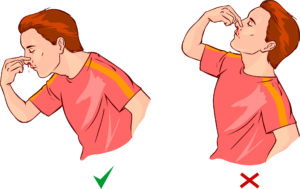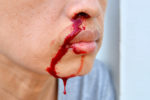 Nose Bleeds are common in children and adults and in most cases are easily treated. Nosebleeds can be distressing to children and be embarrassing to adults. Blood vessels in the nose are close to the skin and easily damaged by putting things in the nose, as well as stress and illness. Nosebleeds can also be from physical impact to the nose by falling or being hit in the face. Be careful when stopping the nosebleed if you think the nose may be broken or if there are any external injuries.
Nose Bleeds are common in children and adults and in most cases are easily treated. Nosebleeds can be distressing to children and be embarrassing to adults. Blood vessels in the nose are close to the skin and easily damaged by putting things in the nose, as well as stress and illness. Nosebleeds can also be from physical impact to the nose by falling or being hit in the face. Be careful when stopping the nosebleed if you think the nose may be broken or if there are any external injuries.Treatment for Nose Bleeds
Treatment of someone with a nosebleed is first to get them to sit down. If needed, calm and reassure them. Lean them forward to maintain an airway. If they lean their head forward, blood can flow down the throat and induce vomiting or nausea. Get them to pinch the soft part of the nose to help stop the bleed. You may want to give them a bowl so they can spit out blood rather than swallow if needed and give them tissues. Leave the pressure on for ten minutes then gently remove the pressure to see if the bleed has stopped.
If it has not stopped, repeat with another ten minutes. If the bleed has not stopped in 30 minutes then you will need to take them to a medical professional. Tell them to avoid sniffing, coughing, blowing nose or talking as these can all cause the bleed to start again and prevent healing.
Regular nose bleeds may be an indication of something more serious and a visit to a doctor is advised. Children who suffer from regular nosebleeds, often outgrow them without medical treatment.
For more information on training courses, visit our “Courses” page which also includes our First Responder and First Person on Scene (FPOS) Courses.


Pingback: Coagulopathy